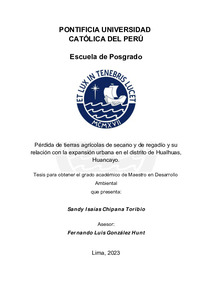| dc.contributor.advisor | González Hunt, Fernando Luis | |
| dc.contributor.author | Chipana Toribio, Sandy Isaías | |
| dc.date.accessioned | 2023-10-13T16:45:55Z | |
| dc.date.available | 2023-10-13T16:45:55Z | |
| dc.date.created | 2023 | |
| dc.date.issued | 2023-10-13 | |
| dc.identifier.uri | http://hdl.handle.net/20.500.12404/26177 | |
| dc.description.abstract | La presente investigación se centra en el análisis de relación entre la pérdida de tierras
agrícolas, tanto de secano como de regadío, y la expansión urbana en el distrito de
Hualhuas, provincia de Huancayo. Fenómeno que compromete la seguridad
alimentaria de las personas y principalmente de las familias dedicadas a la agricultura
autárquica, experimentado así cambios cuantitativos en el uso en estas tierras. Este
estudio se sustenta en el análisis temporal de las áreas con fines de uso urbano y de
uso agrícola para el periodo 1963 – 2021, mediante la técnica de fotointerpretación de
fotografías aéreas e imágenes satelitales en un entorno de Sistemas de Información
Geográfica (SIG). Los resultados preliminares fueron contrastados con información de
campo y entrevistas semiestructuradas de actores claves. Asimismo, se identifica los
principales patrones de ocupación urbana que se han generado en el distrito basados
en la propuesta de Aguilera (2008) por medio de criterios cualitativos de accesibilidad,
de la relación de continuidad de áreas urbanas ya existentes con las nuevas
morfologías, el grado de compacidad del crecimiento urbano y su temporalidad.
Como resultado, la expansión urbana en estas seis décadas tuvo un crecimiento
significativo, originado por factores como el aumento demográfico e influenciado por la
inmigración, pasando de una superficie ocupada en 22.02 ha para el año 1963, 30.53
ha para el año 1984, 53.22 ha para el año 2007 y 132.19 ha para el año 2021. Por otra
parte, en las áreas agrícolas de secano y regadío se apreció cambios en cuanto a su
superficie, observándose así en estos últimos años una reducción de sus áreas por el
crecimiento urbano y el fenómeno de lotización en el distrito. Las tierras de secano
macaron una tendencia de aumento hasta la primera década del año 2000, siendo
286.77 ha para el año 1963, 285.37 ha para el año 1984, 340.62 ha para y 307.70 ha
para el año 2021. Y las que se encuentran bajo riego se redujeron en estas últimas
décadas, siendo 316.39 ha para el año 1963, 339.58 ha, 327.21 para el año 2007 y
305.50 ha para el año 2021. | es_ES |
| dc.description.abstract | This research focuses on the analysis of the relationship between the loss of
agricultural land, both rainfed and irrigated, and urban sprawl in the district of
Hualhuas, province of Huancayo. Phenomenon that compromises the food security of
people and mainly of families dedicated to self-sufficient agriculture, thus experiencing
quantitative changes in the use of these lands. This study is based on the temporal
analysis of the areas for urban use and agricultural use for the period 1963 - 2021,
using the technique of photo-interpretation of aerial photographs and satellite images in
a Geographic Information Systems (GIS) environment. The preliminary results were
contrasted with field information and semi-structured interviews with key actors.
Likewise, the main patterns of urban occupation that have been generated in the
district based on the proposal of Aguilera (2008) are identified through qualitative
criteria of accessibility, the relationship of continuity of existing urban areas with the
new morphologies, the degree of compactness of urban growth and its temporality.
As a result, the urban sprawl in these six decades had a significant growth, caused by
factors such as the demographic increase and influenced by immigration, going from
an occupied area of 22.02 ha for the year 1963, 30.53 ha for the year 1984, 53.22 ha
for the year 2007 and 132.19 ha for the year 2021. On the other hand, in the rainfed
and irrigated agricultural areas, changes were observed in terms of their surface, thus
observing in recent years a reduction in their areas due to urban growth and the
subdivision phenomenon in the district. Rainfed land showed an increasing trend until
the first decade of the year 2000, being 286.77 ha for the year 1963, 285.37 ha for the
year 1984, 340.62 ha for and 307.70 ha for the year 2021. And those that are under
irrigation They were reduced in recent decades, being 316.39 ha for the year 1963,
339.58 ha, 327.21 for the year 2007 and 305.50 ha for the year 2021. | es_ES |
| dc.language.iso | spa | es_ES |
| dc.publisher | Pontificia Universidad Católica del Perú | es_ES |
| dc.rights | info:eu-repo/semantics/openAccess | es_ES |
| dc.rights.uri | http://creativecommons.org/licenses/by-nc-sa/2.5/pe/ | * |
| dc.subject | Tierras agrícolas--Perú--Hualhuas (Huancayo : Distrito) | es_ES |
| dc.subject | Irrigación--Perú--Hualhuas (Huancayo : Distrito) | es_ES |
| dc.subject | Desarrollo urbano | es_ES |
| dc.subject | Seguridad alimentaria | es_ES |
| dc.title | Pérdida de tierras agrícolas de secano y de regadío y su relación con la expansión urbana en el distrito de Hualhuas, Huancayo | es_ES |
| dc.type | info:eu-repo/semantics/masterThesis | es_ES |
| thesis.degree.name | Maestro en Desarrollo Ambiental | es_ES |
| thesis.degree.level | Maestría | es_ES |
| thesis.degree.grantor | Pontificia Universidad Católica del Perú. Escuela de Posgrado | es_ES |
| thesis.degree.discipline | Desarrollo Ambiental | es_ES |
| renati.advisor.dni | 07780096 | |
| renati.advisor.orcid | https://orcid.org/0000-0003-1821-6064 | es_ES |
| renati.author.dni | 43819521 | |
| renati.discipline | 521547 | es_ES |
| renati.juror | Sabogal Dunin Borkowski, Ana Bozena | es_ES |
| renati.juror | Gonzalez Hunt, Fernando Luis | es_ES |
| renati.juror | Moschella Miloslavich, Paola | es_ES |
| renati.level | https://purl.org/pe-repo/renati/level#maestro | es_ES |
| renati.type | https://purl.org/pe-repo/renati/type#tesis | es_ES |
| dc.publisher.country | PE | es_ES |
| dc.subject.ocde | https://purl.org/pe-repo/ocde/ford#1.05.08 | es_ES |







